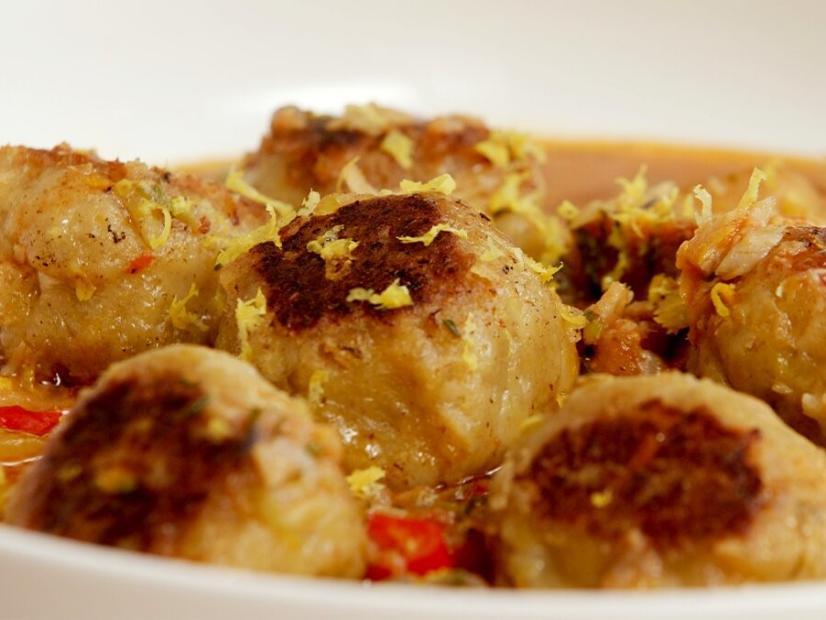
Caribbean Ñoqui with Salted Fish Guisado Criollo
- Level: Advanced
- Total: 1 day 1 hr 45 min (includes soaking time)
- Active: 1 hr 30 min
- Yield: 4 to 6 servings
-
- Nutritional Analysis
- Per Serving
- Serving Size
- 1 of 6 servings
- Calories
- 486
- Total Fat
- 19 g
- Saturated Fat
- 8 g
- Carbohydrates
- 56 g
- Dietary Fiber
- 5 g
- Sugar
- 20 g
- Protein
- 26 g
- Cholesterol
- 146 mg
- Sodium
- 988 mg
- Level: Advanced
- Total: 1 day 1 hr 45 min (includes soaking time)
- Active: 1 hr 30 min
- Yield: 4 to 6 servings
-
- Nutritional Analysis
- Per Serving
- Serving Size
- 1 of 6 servings
- Calories
- 486
- Total Fat
- 19 g
- Saturated Fat
- 8 g
- Carbohydrates
- 56 g
- Dietary Fiber
- 5 g
- Sugar
- 20 g
- Protein
- 26 g
- Cholesterol
- 146 mg
- Sodium
- 988 mg
Ingredients
Salted Fish Guisado Criollo:
Sweet Plantain Ñoqui:
Serving:
Directions
- For the salted fish guisado criollo: Rinse exterior salt off the fish. Soak the fish in a large bowl of water for 24 hours, changing the water 3 times. Drain the fish, remove any bones and set aside (see Cook's Note).
- Heat the oil in a medium Dutch oven or other heavy-bottomed pot over medium heat. Then add the onion and cook, stirring, until softened and translucent, about 3 minutes. Add the adobo, oregano and black pepper and toss with the onions. Add the bell peppers, cover and cook just until softened, 3 to 4 minutes. Add the garlic paste, tomato sauce and vegetable broth. Cover and cook until the vegetables soften and absorb flavor from the broth, 3 to 4 minutes. Add the fish and nestle into the guisado. Decrease the heat to low, cover and cook until the fish is completely coated with the guisado and heated through, 3 to 5 minutes. Flake the fish with a fork to incorporate it into the guisado without completely breaking apart the fish. Taste and season with salt, if necessary. Add the thyme, scallions and cilantro. Keep warm while you make the ñoqui.
- For the sweet plantain ñoqui: Bring a large pot with enough water to cover the plantains to a boil. Add the plantains, cover and cook over medium heat until fork tender but not falling apart, 20 to 25 minutes. Remove the plantains to a wire rack to cool for 3 to 4 minutes. Halve each plantain lengthwise and, using a 1/4 teaspoon measure or small spoon, scoop out the seeds as best you can and discard them.
- Place the plantains, 3 tablespoons of the butter, the egg yolks, brown sugar, nutmeg, lemon zest and salt in a food processor. Pulse until thoroughly combined. Add 1/2 cup of the flour and process until a very loose but sticky dough forms. Transfer to a heavily floured work surface. If the dough feels too loose, fold in 1 to 2 more tablespoons of flour.
- Divide the dough into 1-tablespoon portions. Flour your hands or gloves and shape each portion into a ball. Place the remaining 1/2 cup flour in a small bowl, for dredging the ñoqui. Toss and roll each ball in the flour, shaking off the excess, then transfer to a wire rack set over a baking sheet.
- Fill the large pot with 2 quarts water and bring to a boil. Cook half of the ñoqui, stirring gently once added, until they float, 2 to 3 minutes. Transfer to the wire rack with a slotted spoon and let drain for about 1 minute. Repeat with the remaining ñoqui.
- Meanwhile, melt the remaining 2 tablespoons butter in a medium to large sauté pan over low to medium heat. Add the first batch of boiled ñoqui and cook until browned and seared, lowering the heat as needed to avoid burning, about 2 minutes per side. Repeat with the second batch of boiled ñoqui.
- For serving: Nestle some of the ñoqui with its brown butter sauce into a bowl of salted fish guisado criollo. Sprinkle with some of the zest and drizzle with your favorite hot sauce, if you like it spicy!
Cook’s Note
Many organic adobo seasonings contain less salt than conventional brands. If using organic, increase the amount of salt according to taste. You'll need to soak the salted fish for 24 hours before starting the guisado. You can make the guisado entirely in advance and keep it warm or cook it while you boil the plantains for 20 to 25 minutes.
Looking for Something Else?
Related Pages
- Nana's Banana Cake with Salted Caramel...
- Vanilla Rum Panna Cotta with Salted Caramel Recipe
- Jam Tart with Salted Cracker Crust Recipe
- Spicy Cinnamon Brownies with Salted Peanut Butter...
- Chelsweets Chocolate Cake with Salted Caramel...
- Honey Butterscotch Fondue with Salted Pecan...
- Coconut Cream Pie with Salted Lime Caramel Recipe
- Mofongo Stuffed with Criollo Shrimp Stew Recipe
- Pabellon Criollo Recipe






























